How are Smaller Cities Driving Mutual Fund Growth in the Post-COVID Era?

Synopsis
Key Takeaways
- Smaller cities are leading in mutual fund growth.
- B30 cities account for 18.5% of total AUM.
- Assets from smaller towns have grown at a CAGR of 28%.
- Financial literacy and digital access are key drivers.
- Investment culture is spreading beyond metros.
New Delhi, Aug 10 (NationPress) In the aftermath of COVID-19, investments in mutual funds have surged significantly, with smaller towns and cities emerging as unexpected frontrunners in growth. According to data from the Association of Mutual Funds in India (AMFI), assets from B30 cities—those beyond the top 30—have been expanding more rapidly than those from larger urban areas.
As of June 2025, B30 regions represented 18.5 percent of the total mutual fund assets under management (AUM), amounting to nearly Rs 14 lakh crore out of the industry’s total AUM of Rs 75 lakh crore.
Over the past five years, the assets from these smaller cities have experienced a compounded annual growth rate (CAGR) of 28 percent, in contrast to the 23 percent growth in T30 cities.
The overall industry AUM also increased at an annual rate of 24 percent during the same timeframe, as indicated by the report.
This trend is reshaping the geographical landscape of investments across the nation. States like Uttar Pradesh, Rajasthan, and Madhya Pradesh—historically viewed as less affluent—have now surpassed wealthier states in mutual fund asset rankings.
Currently, Uttar Pradesh boasts more AUM than Tamil Nadu, while Rajasthan has outperformed Telangana, and Madhya Pradesh is ahead of Kerala.
Industry specialists argue that factors such as enhanced financial literacy, better digital accessibility, and the popularity of systematic investment plans (SIPs) have enabled smaller cities to close the gap rapidly.
This shift signals a transformation in India’s investment culture, which is no longer confined to metropolitan areas but is expanding into Tier-2 and Tier-3 regions.
This trend reflects broader economic movements, where smaller cities are becoming pivotal in sectors like e-commerce, fintech, and retail.
Experts believe that the mutual fund industry’s penetration into new regions could bolster capital markets and encourage greater retail participation in the future.










